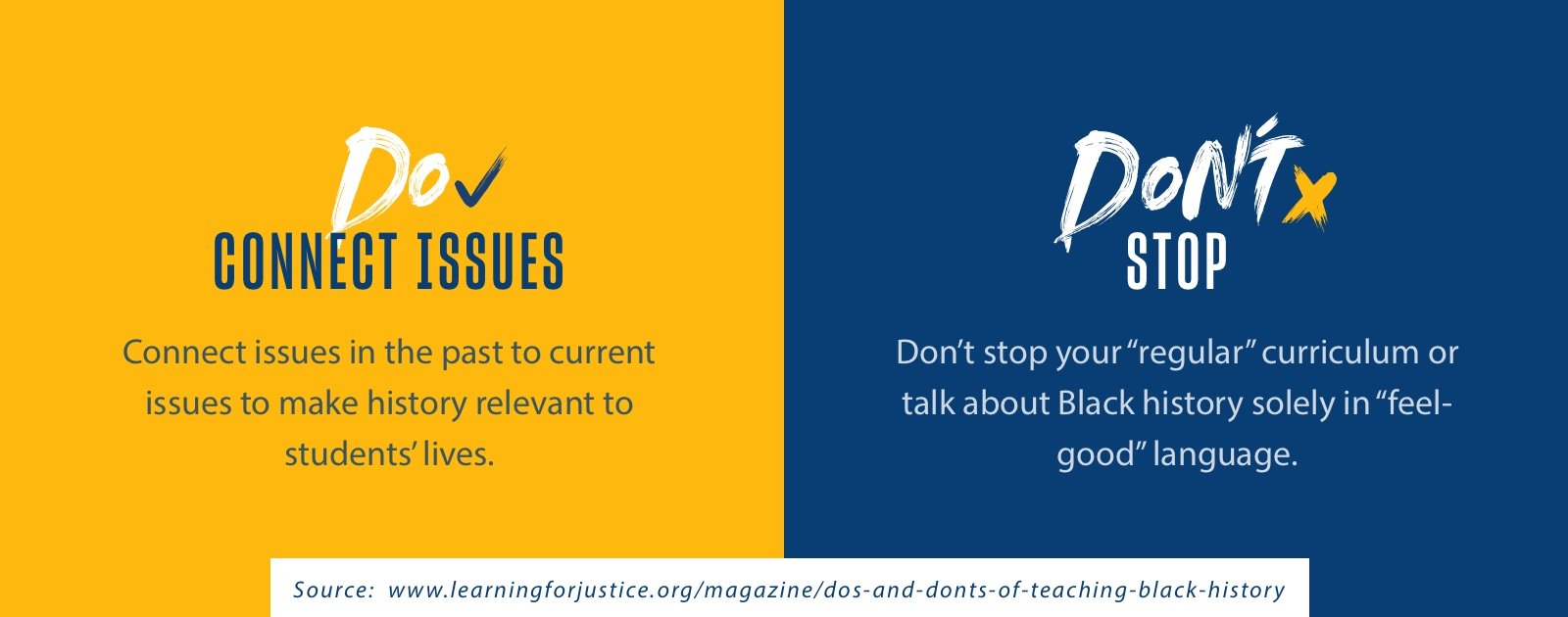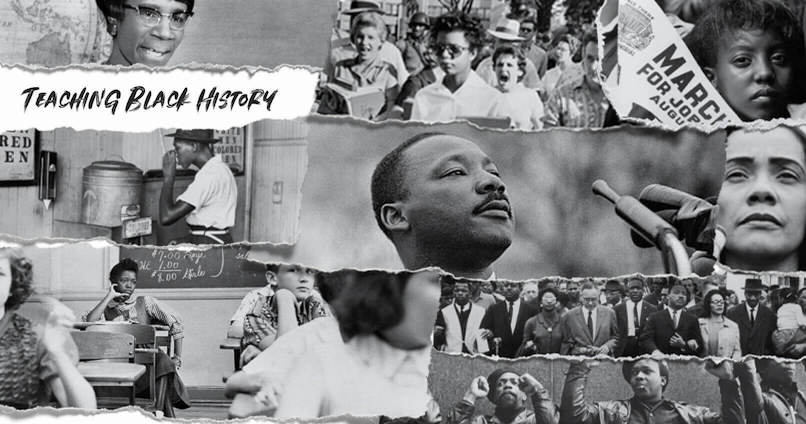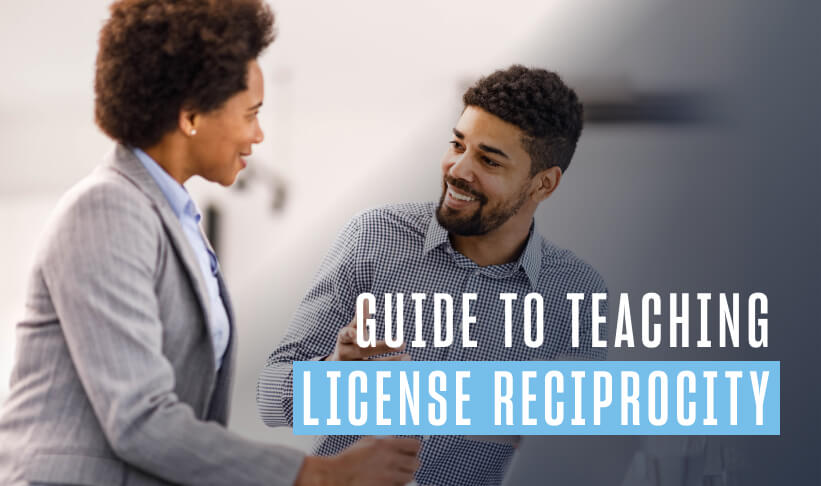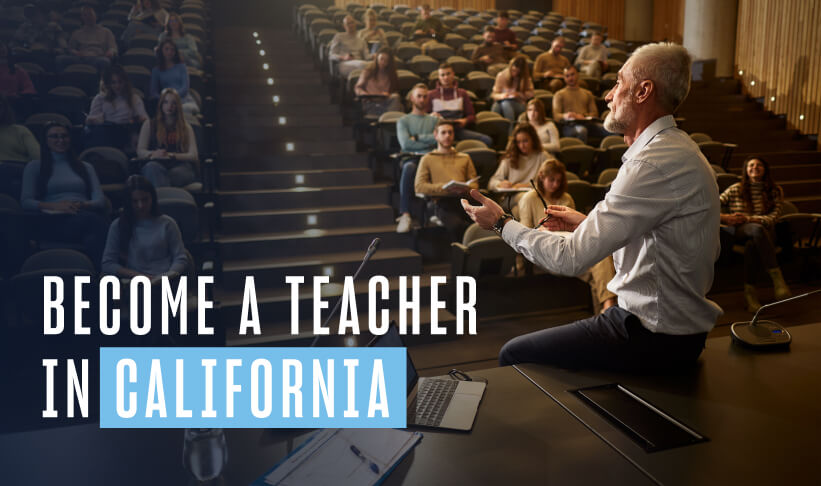Some years, Black History Month seems more important than ever.
On February 1, 2021, President Joe Biden offered these words: “This February, during Black History Month, I call on the American people to honor the history and achievements of Black Americans and to reflect on the centuries of struggle that have brought us to this time of reckoning, redemption, and hope.”
Of course, as educators across our great nation are aware, teaching Black History Month presents unique challenges due to the hard reality of certain aspects of the history, and current reality, of the Black lived experience in America.
Here, I would like to offer some ideas for teachers looking to enrich their February curriculum by creating meaningful Black History Month educational experiences for their students. In doing so, I think a good starting point would be to share a quick history lesson.
The History of Black History Month
The roots of our nation’s annual observance of Black History Month date back 105 years (that’s 1,260 months for you math enthusiasts) to 1915. That’s when the Harvard-trained author/historian Dr. Carter G. Woodson founded the Association for the Study of Negro Life and History (now called the Association for the Study of African American Life and History).
Half a century earlier, Congress had enacted the Thirteenth Amendment abolishing slavery in the United States, moved to action in part thanks to President Abraham Lincoln’s landmark 1863 Emancipation Proclamation.
| Possible Black History Month classroom discussion topic:
The power and presence of poetry — and, yes, even rhymes — in the words that great leaders have used to uplift and challenge mankind. From President Lincoln to the legendary civil rights leader and human rights activist Rev. Dr. Martin Luther King (“Injustice anywhere is a threat to justice everywhere”) to the deeply inspiring words offered by National Youth Poet Laureate Amanda Gorman at President Biden’s Jan. 20 inauguration. |
In 1926, Dr. Woodson and his group announced the observance of a Negro History Week, choosing the second week in February in recognition of the birthdays of Abraham Lincoln (Feb. 12) and Frederick Douglass (Feb. 14), dates that had been celebrated together by Black communities since the late 19th century.
Half a century later, during America’s bicentennial, Gerald Ford became the first U.S. president to officially recognize Black History Month, according to AfricanAmericanHistoryMonth.gov. Presented by the Library of Congress, this resource site features a rich assemblage of exhibits and collections, audio and video and Black History Month educational resources curated especially for teachers.
Black History Month Education: “Do’s and Don’ts”
One concept that I believe is particularly important to help put our Black History Month educational efforts in context (from “Do’s and Don’ts of Teaching Black History” by LearningForJustice.org) is the suggestion that teachers: “Reinforce to students that ‘black’ history is American history. Make black history relevant to all students.”
Or, as Black History Month founding father Dr. Carter G. Woodson put it, speaking aspirationally: “What we need is not a history of selected races or nations, but the history of the world void of national bias, race hate, and religious prejudice.”
Other key recommendations from the article cited above include:

LearningForJustice.org, an educational resource organization whose mission is focused on advocating for racial justice and human rights, has also just published a compelling and thought-provoking examination of how we teach Black history.
Titled “Black History Month: Teaching the Complete History,” the article encourages teachers to “Go beyond trauma and struggle to examine the liberation, civic engagement, creativity and intersecting identities of Black people during Black History Month.”
This suggestion springs from the fact that: “It is not uncommon for educators to focus on slavery, segregation and other forms of oppression during Black History Month. But only teaching a Black history steeped in trauma and struggle provides a very narrow view of Blackness and perpetuates the false notion of Black people’s inferiority.”
There is abundant online research available to help teachers craft meaningful Black History Month educational experiences for their students. Next, we’ll take a look at some helpful teaching tools and resources.
Black History Month: Teaching Tools and Resources
“Black History Month: Teaching the Complete History”
This article, published by LearningForJustice.org and cited above, offers four specific areas worthy of examination by teachers and their high school-aged students during Black History Month (or at any time of year). Check out the article for ideas.
- Teaching the History of Black Liberation Movements
- Honoring Black Civic Engagement
- Recognizing Intersectional Black Identity
- Celebrating Black Literature
Black History Month Lessons & Resources | National Education Association (NEA)
The NEA offers a selection of lesson plans geared to Grades K–5, 6–8 and 9–12 on the theme of “integrating African-American culture and history into your curriculum.”
Black History Month Lesson Plans and Teaching Resources | Scholastic
Scholastic, a leading provider of literacy curriculum, education-related services and classroom magazines, presents a collection of resources for students in Grades 1–2, 3–5 and 6–8, with subject matter organized under headings like:
34 Black History Month Activities for February and Beyond | We Are Teachers
We Are Teachers invites teachers to “honor our shared history with activities for the entire classroom,” providing a list of hands-on ideas and links to helpful resources. Here are just a few of their ideas:
- Create a newsletter or magazine.
- Turn your classroom into a living museum.
- Recreate a Black family’s journey using the Green Book.
- Honor some of the military’s most courageous veterans.
- Visit the Smithsonian National Museum of African American History & Culture.
Say Their Names; Teach Their Stories
When it comes to heroes, Black history obviously isn’t just about Harriet Tubman, George Washington Carver, MLK and Rosa Parks. There are also countless inspirational, often lesser-known figures in American history who have made profound contributions to the country we all share.
Biography.com tells many of their stories on a comprehensive Black history page that educators can visit for ideas and lesson topics. For example:
- Benjamin Banneker Wrote Thomas Jefferson Challenging the Founding Father’s Contradictory Views on Race and Freedom
- Daniel Hale Williams Performed the First Successful Open Heart Surgery During an Emergency Procedure
- 9 Key Figures of the Harlem Renaissance
- The Power of Words: The Writer James Baldwin
- How Carter G. Woodson’s Life’s Work Fueled the Creation of Black History Month
Oprah Winfrey, one of America’s most influential personalities, shares the stories of “26 Black Americans You Don’t Know But Should” on OprahMag.com along with the words, “Educators, activists, and historians have long been attempting to shine a light and pinpoint why so much African American history is missing from our nation’s curriculum.”
For an elegantly designed, thoughtfully curated exploration of 44 influential African-Americans (some of whom you have heard of and others you probably have not), I highly recommend visiting “The Undefeated 44” to discover beautifully illustrated stories of Black Americans who “shook up the world or at least their corner of it.”
Black History Month: Watch This!
Video is, of course, a powerful teaching tool and you will not be surprised to learn that YouTube has an incredible volume of Black History Month videos, many of which have value for educators.
Here are just a few: starting with James Baldwin’s legendary “pin drop” speech (kids today would call it a “mic drop”) during a debate with conservative icon William F. Buckley at Cambridge University in 1965.
- Kids Explain Black History Month
- “The ABC’s of Black History” – Read Aloud
- Can Kids Change The World? | Black History Month For Kids
- The Story of Martin Luther King Jr. by Kid President
- Black History is American History | Okalani Dawkins | Youth TED Talks
- Untold Stories of Life in Mississippi | Medgar Evers Home Museum
- Black History Month: The meaning behind Juneteenth
- Black History Month Around The World
In America, there is a tradition of teachers and parents encouraging children of all races by telling them that if they work hard in school and in life, and treat everyone they meet with respect, that they can grow up to be whatever, whoever they want to be — even president of the United States.
(Or, in my case, program director of the University of San Diego’s Master of Education degree, a job that recently afforded me the opportunity to make a video on the topic: “Teaching Race in the Classroom: Philosophy, Strategies and Techniques.”)
Here is one additional video that reinforces the time-honored theme mentioned above: “Kid President meets the President of the United States of America” (16.5 million views) is a fun, heartwarming look at one young man’s 2013 White House visit with Barack Obama, America’s first Black president.
The Commitment to Social Justice
The topic of how we teach Black History Month is very close to my heart, in part because my university’s core values include a deep commitment to addressing issues of social justice in our communities and in the world around us. At the University of San Diego, we are mindful of striving to help our students graduate with a global perspective as compassionate citizens and ethical leaders.
If you would like to learn more about a unique opportunity to immerse yourself in an academic experience that is designed to empower and inspire you with expanded skills and insights, I invite you to explore our online University of San Diego Master of Education program.





